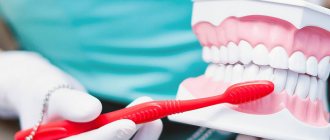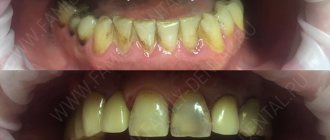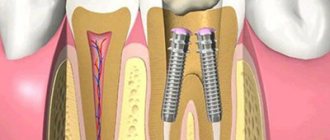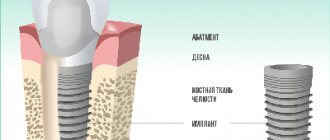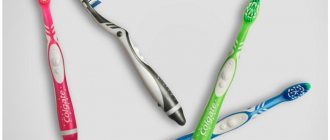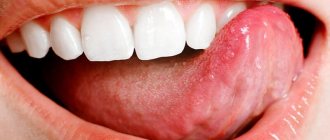When studying the price list of any dental clinic, patients see something like the following:
If everything is more or less clear with the first and last points, then what about an orthopedic dentist, periodontist, implantologist and orthodontist? Who are they and what do they do? And which of them wears dentures?
Everything is simple here:
- Dentist-therapist: treats caries, pulpitis and periodontitis, puts fillings. Works with tooth root canals. In our clinic, therapists are trained in artistic dental restoration.
- Dentist-surgeon: removes teeth, performs tooth-preserving operations. If he has the necessary knowledge, he carries out the surgical part of dental implantation - the direct installation of the implant.
- Orthopedic dentist: deals with dental prosthetics. Crowns, inlays, removable dentures are his element. Orthopedic dentists also perform prosthetics on implants that are pre-installed by his colleague, a dental surgeon.
- Dentist-periodontist: gum disease is the domain of the periodontist. Bandages, mouthguards, ointments are his arsenal. Performs hygienic cleaning of the oral cavity (tartar removal, Airflow). In difficult cases, he performs operations on the gums (periodontics is a discipline related to surgical dentistry).
- Implantologist: deals with the installation of dental implants and subsequent prosthetics on them. Sounds familiar? That's right, a dental surgeon and an orthopedic dentist can do the same thing, working in tandem.
- Orthodontist: corrects bites for adults and children. His tools are plates, trainers, and bracket systems. As a result, orthodontic patients receive straight teeth and their correct alignment.
- Pediatric dentist: deals with the treatment and removal of baby teeth, silvering. It can promptly prompt parents that it is time for their child to see an orthodontist in order to solve a bite problem at an early age.
History of the profession
The very first mentions of dental therapy are found in the history of Ancient Egypt. Tools similar to modern analogues have been found more than once in tombs. Many more Egyptian skulls with crowns on their teeth were also discovered there, and these were not only rich people. Judging therefore, it can be said that some types of dentistry were developed in Egypt. In addition, the first toothpaste was mentioned at the same time . It included:
- ashes of the burnt entrails of a bull;
- ground eggshell;
- myrrh;
- crushed pumice.
Then in the IV-V centuries. BC, the great Hippocrates became interested in this science. He recommended eliminating pain with a hot iron. At that time, many people suffered from toothache and did not understand how to deal with it. Fatalities from common flux were common, and during the time of Hippocrates, dentistry advanced several steps forward.
In your free time from work, you can earn extra money
on freelance exchanges (by writing comments, reviews, or simple actions on social networks) - choose what you like best and start earning money!
The first toothbrushes appeared in the Middle East in 500 AD. And in the 4th century AD. e. found forceps used to pull out bad teeth. And also powerful drugs that relieve pain appeared: arsenic and opium. Therefore, people began to understand that there is no need to rush to remove teeth, but that they can be treated. So, in 659 the first fillings appeared.
This specialization developed, and already in Russia, during the reign of Peter I, the profession of dentist officially arose, and rapidly became popular among men and women. In 1881, the first educational institution appeared in St. Petersburg, which trained future dentists. Then such institutions began to open throughout Russia.
February 9 is considered to be International Dentist Day, which falls on the day of St. Apollonia. After all, it was she who accepted martyrdom for Christ. She was tortured with forceps, which caused hellish pain.
Implantologist
Implantology is a narrow specialization of dental surgery. An implantologist restores missing teeth in the mouth by implanting artificial roots (implants) into the jaw bones. Problems solved by an implantologist:
- absence of one or more teeth in a row;
- complete edentia;
- atrophy of the jaw bone.
The implantologist works in close collaboration with the orthopedist, since after implantation the patient is sent to the orthopedic office for prosthetics.
Types of specialization
This type of activity is multidisciplinary and covers a wide range of activities. Therefore, modern science has divided this branch of knowledge into a number of specialized specialties:
- Dentist-therapist . You can find out what this doctor does if a person has dental problems and pain. His responsibilities include a preliminary examination of the patient’s teeth and prescribing subsequent treatment. He also treats caries and inflammation in the oral cavity. After examination and diagnosis, the doctor refers you to specialized specialists.
- Prosthetist . If the therapist did not cope with the task, then people come to this doctor. He deals with prosthetics and offers different options to patients. Then he makes a description, impressions of the teeth and adjusts them to the particular structure of the patient’s mouth.
- Dental hygienist . Examines the oral cavity, removes plaque, polishes enamel and advises people on the prevention of dental diseases.
- Orthopedist . It is based on the removal of distortions in the bite and the installation of different types of orthopedic dentures - removable, fixed and combined, and also corrects the position of the teeth in the oral cavity.
- Surgeon . You cannot do without it, because there are cases when surgical intervention is necessary. The surgeon prepares the oral cavity for the upcoming procedure of inserting dentures. His competence includes jaw practice, treatment of wounds on the face and mouth, and jaw restoration.
- Maxillofacial surgeon . The specialty of these doctors was complex operations of various types using general anesthesia and correction of the jaw area.
- Pediatric dentist . In young children, baby teeth have certain characteristics, and working with them requires skills. In addition, the pediatrician must get along with children so that they are not afraid before the procedure.
- Orthodontist . Unlike an orthopedist, he deals primarily with exceptional cases, anomalies, and deviations in the development of the jaw.
- Periodontist . Specializes in the gums and soft tissues that support and surround teeth. Consults patients about bleeding gums, the appearance of tartar and plaque on teeth.
All these names, or rather, specialties, can be mastered at the Faculty of Dentistry of a medical university. The first 2-3 years are spent on general training, and then there will be training in a specific profession. It is for this that you need to pass the exam for the category.
Orthopedist
If the help of a therapist and periodontist did not produce results and the tooth could not be saved, it becomes necessary to install a prosthesis. This is what orthopedists do. At the first stage, their task is to obtain an impression of the tooth. Based on the results obtained, the dental technician makes a prosthesis. After this, the orthopedist first performs the so-called fitting, and then the final installation of the artificial tooth. There are many different options for prosthetics, from installing crowns to using removable jaws.
Konychev Evgeniy Alexandrovich
orthopedic dentist
More details
Turovets Alexander Igorevich
orthopedic dentist
More details
Job Responsibilities
Even at the institute, immediately after admission, the student is prepared for future work and clearly delineates what will become his vocation.
Job responsibilities of a dentist include:
- carrying out diagnostics and providing all types of dental services to the patient;
- treatment of teeth, oral cavity and maxillofacial area;
- preparation of dental and orthopedic instruments and their correct use for their intended purpose, adhering to safety precautions;
- collection of biomaterial for analysis;
- carrying out prevention, diagnosis and treatment of all types of caries;
- correct removal, prosthetics and installation of fillings;
- registration of medical documentation established by law;
- compliance with job instructions.
These are mandatory items that require strict implementation.
What does therapeutic dentistry do?
So, since we have touched on the topic of dividing the scope of activity of dentists, let’s take a closer look at the possibilities of therapeutic dentistry. First of all, it is worth paying attention to the fact that quite often dentists combine several specialties and a highly qualified therapist can also successfully perform the duties of a periodontist or orthopedist.
But first things first: the following health problems can put you in the chair of a dentist-therapist:
- caries,
- pulpitis,
- various fluxes,
- periodontitis,
- nerve inflammation
- gingivitis.
The main work of a dentist in this area is the artistic restoration of teeth using a wide variety of filling materials and technologies. Quite often, they also prepare the oral cavity for prosthetics.
Requirements for a dentist
In addition to the clearly limited responsibilities that define the work of a doctor, there are also qualification indicators that are used to guide the employment of specialists.
People who:
- have a diploma with higher medical education, a certificate of a certain specialization;
- passed a medical examination and received a medical certificate;
- have experience in this field;
- have computer skills;
- presence of responsibility, sociability, attentiveness and accuracy.
Personal qualities and skills are no less important for this profession. These include:
- the presence of excellent coordination of movements, hand motor skills, excellent vision;
- knowledge of human anatomy and physiology;
- understanding the effects of medications used in dentistry;
- ability to use specialized instruments, as well as an X-ray machine and interpret images.
It is inherent in a dentist to be a bit of a psychologist, to be able to communicate with nervous patients, to correctly explain the situation in order to relieve nervousness and calm the patient.
Principles of training
If you decide to become a dentist, then you need to understand that this profession is very responsible. Therefore, it is necessary to obtain a medical education.
Those who are interested in dentistry are wondering: how long to study to become a dentist and what is needed for this. To enter a university, you must:
- complete 11 grades in a secondary school;
- pass the appropriate exams in biology, chemistry and Russian.
It is necessary to understand whether a person is ready for this profession. To obtain a specialty in this field, you need good study and a specific goal, as well as the ability to find an approach to even the most picky and harmful patients.
Salary and place of work
As mentioned earlier, the profession is in demand and profitable. Therefore, dentists have a wide choice of places to work:
- public and private clinics;
- dental offices;
- sanatoriums and children's institutions.
Factors that affect wages are length of service, qualifications and region.
Salaries in the specialty range from 30,000 to 100,000 rubles, and in large cities you can earn much more. As practice shows, in private clinics the income is much different compared to public clinics. On average, it is 45,000 rubles.
Resume sample
To find a job faster, you need a resume that can be sent to several companies at once. You need to know how to compose it correctly.
The resume must include:
- Full Name;
- Date of Birth;
- contact details: phone, email;
- citizenship;
- experience;
- basic and additional education;
- professional skills;
- knowledge of languages;
- personal qualities.
The resume should be simple and understandable; there is no need to write or invent a lot, because then in practice all the qualities and abilities of the specialist will be assessed.
The difference between a dentist and a dentist
A dentist is a dentist who is a paramedic. This concept is more commonly used abroad; in some countries it simply has not taken root.
This profession differs in the type of education. You can study at a medical school, college and get a secondary education to become a dentist, but dentists only need a higher education. Accordingly, their specialization will be different.
Responsibilities of a dentist:
- examination of the patient, making a primary diagnosis;
- gum treatment;
- installation of seals;
- oral hygiene instructions;
- provision of pre-medical care and referral to specialists;
- assistance in choosing toothpaste and brush.
A dentist is trained to work with simpler cases than a dentist, so his income will be different.
One or more?
Many patients are simply sure that dentist, dentist, and dentist are synonyms, a reflection of one specialty, and there is no difference between these concepts. In fact, there are, one might say, fundamental differences.
We invite you to familiarize yourself with a review of popular ointments for the treatment of stomatitis in young patients
It is no coincidence that in many clinics there are several offices in which dentists of different specialties see: therapists, surgeons, orthopedists, orthodontists, etc. Some clinics practice four-handed work, where there is a leading dentist and his assistant, who can be a dentist or dentist doctor.
Advantages and disadvantages
As in any profession, it is not the subject that matters, how much dentists earn, but the positive and negative nuances.
The positive aspects of working as a dentist include:
- qualifications are in demand in all countries of the world;
- high profit payment;
- normal working hours;
- Private practice is possible when you have a lot of experience.
There are also negative indicators that should not be forgotten. The negative aspects include:
- greater responsibility for the patient;
- high cost of training;
- possible stressful situations at work;
- competition;
- expensive equipment and tools;
- the need to constantly improve skills;
- working with different people.
Dentistry is a kind of art that has always been considered a prestigious profession. Therefore, every year students enter universities for this specialty in order to learn and then work and receive high wages.
Features of oral diseases
The top of the ranking of diseases that are leading among people who come to the dental office is headed by caries at various stages of its course. From a physiological point of view, the process is explained by the mineralization of enamel. Over time, this guarantees the development of an inflammatory process such as pulpitis. It is localized in the area of neurovascular bundles, which are designed to provide nutrition to the tooth.
Other diseases include:
- periodontitis;
- periodontitis;
- ginvinitis;
- benign neoplasms;
- stomatitis;
- tongue abscesses;
- non-epidemic mumps.
Periodontitis, which is almost as common as caries, involves an inflammatory process that selects the location of the tooth socket. This is the name given to the place where the gum and growing tooth come into contact.
If the patient is plagued by inflammation of the mucous membranes of the gums, accompanied by a pronounced bad breath, then this indicates ginvinitis. If you delay its treatment at the first stage, it will very quickly lead to periodontitis and gum abscess.
You should not be afraid of diagnoses associated with the detection of cancerous formations on the gums. Usually we are talking about granulomas. Since these tumors are benign, they can be removed without problems.
Another disease that usually does not pose a serious danger, as it often goes away on its own, is stomatitis. The only difficulty here is that during the period of exacerbation the patient suffers greatly due to unpleasant sensations. To treat damage to the oral mucosa, the doctor will recommend special pharmacy rinses. If you follow the instructions, you can get rid of inflammation in two to three days.
According to research, stomatitis in childhood is one of the hidden causes of loss of appetite in babies. They are simply uncomfortable eating, so they are capricious and prefer not to further injure their mucous membranes.
A little less common are traumatic injuries to the jaw, which simply cannot be corrected without the intervention of a maxillofacial surgeon. Another group of rare ailments are tongue abscesses and periostitis.
Sometimes it happens that a victim receives a referral to a dentist after visiting an ENT specialist. This applies to cases with extensive inflammation, when the throat, gums and parotid gland swell. Because of this, it seems as if it is precisely this that is the cause of the pain, and not a dental ailment.


